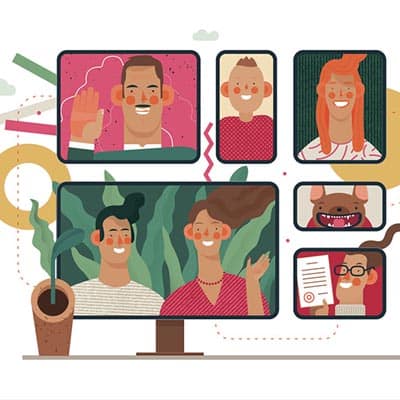Plan Out How Your Files Will Be Organized Solid collaboration depends on coordinated simplicity. When dealing with shared files, which you undoubtedly will when collaborating, you need to keep things simple; and, to have a plan about how your data is structured. One of the best ways to do this is to be consistent and make sure that file folders aren’t misspelled (or forgotten entirely) and are in the right place. Other practices include: Try to keep it to three folder levels deep – You will inevitably go deeper than that, but if you try to keep files as close to the top of the file tree as possible, they immediately become easier to manage. Keep documents that belong together, together – Nothing is worse than going to a folder to find a file that is supposed to be there only to find out that it is kept in another folder. If you have shared resources between projects, make copies and file them along with the other project files. Name folders according to function – When naming folders, it is important that, if someone were to have to search for it, that they can find it. That is why you want to name folders and files according to their practical purpose. Use consistent file types – Have you ever gone looking for a specific file only to find out that the file you were searching for is a completely different type of file? It’s frustrating. Save file types in the manner in which works best for everyone. Remove files that don’t have any business being there – A folder can get very sloppy very quickly. If a file doesn’t belong in a folder, don’t save it in the folder. Train new members on shared file policies – The thing that will make a shared file management platform work the best is workers that understand how the other people using it manage files. Train your new people to ensure they understand. Creating a system to govern how and where files are stored will make a lot of difference when people need access to them. That segues nicely into our next point: Be Collaborative, But Manage Access The more collaborative your organization intends to be, the more time and effort it will have to spend ascertaining just whom should be given access to what. Why? This is because collaboration dictates that people work together, but if there are people who don’t have anything to do with a project, but have access to that project, negative situations can occur. If you simply manage the resource’s permissions, it keeps this situation from becoming a problem. The people who do need access, and who get access, typically are people that are reliable enough to not save files and folders in places where they don’t belong. You may initially find this to be overkill, but the first time that a project (or even a task) falls flat because a member of your team had access they didn’t need and some resources go missing or are corrupted, it will cause problems that nobody needs. Keep Your Platform Secure In file management, simplicity is key; but security is a must. To that end, selecting a thorough file sharing system that encrypts your data is important. Many people have […]
Team Building Getting a project team on the same page can be difficult, even if you are a subscriber to project management software that’s designed to centralize tasks and resources. This is especially true if your business works in multiple locations. With a reliable conferencing solution your team can meet with resources to share files, swap screens, and communicate with other team members. These tools work to boost collaborative efforts, turning what would be confusion into progress. Task Management Regardless of where your team works out of, it can be difficult to keep them working efficiently. There are numerous distractions and speed bumps to consider when working collaboratively. Conferencing solutions allow teams to stay on-task, and waste less time than teams that work without a centralized communications platform. Be More Collaborative Up until recently it was difficult to collaborate with others who weren’t close by. Today, however, conferencing solutions give an organization (or project team) the ability to lean on other team members better than ever. With options to share screens, send files, and directly communicate with your entire team, your organization has all the resources it needs to be more productive. Conferencing Saves Money Through Simplicity Conferencing presents an opportunity to save capital by allowing a project team to standardize their communications platform. The pure number of systems that you need are fewer than ever as some conferencing solutions are delivered through VoIP or productivity tools that you would already be subscribing to. Finding ways to be more effective while also saving money is music to the ears of any business owner. At SRS Networks, we can help you find the communications tools that are right for your business. We can present you with conferencing options that integrate with your current IT infrastructure more than you may think. Call us today at (831) 758-3636 to learn more.
What is a Deepfake, and How Are They Made? A deepfake is a fabricated video that makes it possible to literally put words in someone’s mouth. As demonstrated by multiple research teams, while this technology is not yet perfect, it can be used to create a very convincing video – or an even more convincing still shot. Deepfakes can be made using a combination of techniques and tools. Video Deepfakes Using a specialized software solution, a video is scanned to identify the phenomes (the different sounds that make up full words) that are vocalized. Once they are identified, the phenomes are matched with the facial expressions that produce those sounds (also known as visemes). A 3D model of the subject’s face is then built based on the original video. With the right software solution, these three factors can be combined with a transcript to create new footage and superimpose it over the original, making it appear that the person depicted is saying something that they never said. This creates a video that is just different enough to be disconcerting. A similar method, that relies on mapping the expressions a person makes in source footage and applying them to a second person’s face, can even be used to bring paintings and old photographs to life. Still Image Deepfakes While the still images of people that were produced by AI were initially low-quality and generally unconvincing back in 2014, today’s – just five short years later – are effectively indistinguishable from the real deal. This is thanks to a technique known as a generative adversarial network. Using this technique, one AI generates images of people’s faces, anticipating feedback on how it did. In order to reach the desired level of photo-realism, it could potentially take millions of repetitions – something that nobody has time for. Instead of subjecting a human being to the process of critiquing millions of images, a second AI is used to guess whether the picture was actually created by the first AI, or is a legitimate picture. While neither is particularly effective when first starting out, they swiftly improve in their capabilities over time, and can soon make images that are effectively indistinguishable from actual photographs of real people. Neither of the people pictured here actually exist – they were instead created by NVIDIA in one of their machine learning AI initiatives. As a result, we can see a dramatic rise in the capability for people to spread falsehoods and generally make the Internet a misinformative place. How Misinformative? Let’s look at a relatively recent example of how impactful altered video can be. In May of this year, video of House Speaker Nancy Pelosi blew up on social media that made her appear to be making a speech while intoxicated. Edited to make her sound as though her words were slurred, the original footage had been reduced to 75 percent of its original speed, with the Speaker’s voice adjusted to make it sound more like her natural pitch. This wasn’t the only instance of this happening, either. In addition to this speech, originally delivered at an event for the Center of American Progress, Pelosi’s voice was also manipulated to make her, again, appear drunk as she spoke to the American Road & Transportation Builders Association earlier in May. […]
- 1
- 2



